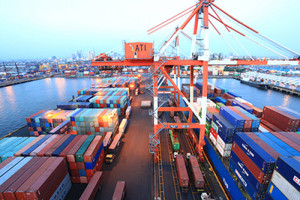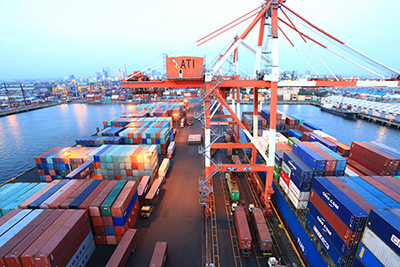(The following is the full statement of Asian Terminals Inc in reaction to the PortCalls story “Truckers assail ATI’s inefficient port operations” published in the paper’s October 1 issue.)

Asian Terminals Inc. (ATI) categorically denied claims by the Confederation of Truckers Association of the Philippines (CTAP) on alleged operational inefficiency and system vulnerability at Manila South Harbor, carried in the “Truckers assail ATI’s inefficient port operations” story of PortCalls on Oct. 1, 2014.
Responding to the PortCalls article, which was based on the group’s letter to Secretary Jose Rene Almendras, ATI executive vice president Andrew Hoad explained that CTAP’s claims are misguided and unfounded and instead invited the group for a more thorough discussion on the Vehicle Booking System (VBS) it is proposing as a sustainable and constructive solution to improving the road logistics chain.
“It is extremely disappointing to see such a letter coming from CTAP because not only are the operational observations incorrect, but the solutions offered are simplistic and misses out on a real opportunity to improve the operating environment for truckers through the VBS,” Hoad said.
VBS is similar to an online airline booking system, like what ATI’s foreign shareholder DP World deploys in over 60 ports globally, which allows ports to position boxes for collection before a truck arrives rather than wait for the truck arrival to trigger resource allocation – as currently operates at Philippines ports.
Hoad went on to address the issues raised in the letter one by one.
Port systems and equipment are adequate
“First of all, ATI is fully compliant with the PPA (Philippine Ports Authority) South Harbor Master Plan, in accordance with timetables,” Hoad said. From 2013-2015, ATI is engaged in the largest investment plan in the history of the company, spending US$50 million per annum for three consecutive years in a row. In 2013, ATI took delivery of four new rubber-tired gantries (RTG) and have another four coming this 2014. A new quay crane (QC) was also installed at Manila South Harbor last year, while terminal land space expansion is ongoing.
“In no universe could ATI seriously be accused of underinvestment,” Hoad stressed.
Operations is not the root cause of problem
ATI’s EVP went on to explain that in a severe congestion environment where yard utilization is permanently jammed above 80%, the worst thing that can be done is deploy extra QCs or extra RTGs as this usually drives down production. Faced with such challenges, typically operators will drop down by a couple of pieces of equipment because the choke point is digging for boxes in a highly utilized yard.
Having more trucks to serve more cranes doesn’t speed up the digging process, conversely clogs truck lanes inside the terminal, and essentially replicating the same traffic gridlock outside the port.
“I don’t think CTAP fully understands the dynamics of efficient port operations,” Hoad said, hence putting no weight on their members’ claim that they have “properly determined the root cause of congestion.” “We are pleased to note that other trucking unions have entered into an extremely constructive dialogue with ATI over the last few weeks and have gained insight to the port. We invite CTAP to do the same.”
Congestion is not perennial
On the comment that congestion is perennially a problem only made worse by the truck ban, Hoad commented: “If that was the case then our monthly utilization reports to the PPA would demonstrate high utilization levels every year. They do not, and the existence of above 80% utilization in off peak seasons like April-August is unprecedented in memory.”
The only factor that was unique in this period was the extended truck ban, so the man in the street would make the observation that a unique utilization percentage reflects a unique event.
Moreover, on the observation of about 4-8 hours truck waiting time, Hoad commented: “Like all ports around the world we measure what we can control, from the turn-time at the gate entry to departure.” Every week ATI measures this in minutes and every week this year, it is measured between 31 and 66 minutes, with 40s on average.
“Do trucks have to queue before they get into the gate? Yes, I don’t know any port in the world where they do not because the ports do not control trucking companies or the road network, and there is always some peaking reflecting factory and warehouse working hours,” Hoad explained.
What ports can do is help the situation by introducing a vehicle booking system. “We are willing to pay and deliver one for the benefit of the whole port community. But in truth I think CTAP would rather carry on with doubling or trebling their prices to consumers even though the truck ban has gone and the roads are clearer.”
Since the truck ban lifting in mid-September, yard utilization has eased, production has picked up and truck transactions have increased. Traffic flow along the major arteries leading to the port has likewise visibly improved, even during rush hours. “An inconvenient truth for CTAP I suspect. Better just to point a finger.”
Systems are not vulnerability to corruption
Neither is the claim that ATI’s port management system is “highly vulnerable to corruption” acceptable because checkers and employees of shipping lines advise delays and then volunteer queue jumping for a fee.
Hoad said: “Let me be absolutely clear and unequivocal about this, ATI has a zero tolerance policy on corruption and any ATI employee assisting checkers or shipping line employees to take tips in this way will be terminated with immediate effect. I have asked truckers to advise names and the silence is deafening. This suggests to me that it is a red herring and probably reflects frustration in not understanding the shipping line empty box allocation system on the ground.”
Just recently, ATI has designed an electronic board system, which functions like a traffic light system in the truck holding area, a system also available online via ATI’s website. This advises waiting truckers on whether there is space for their empties in the port as per shipping line allocation. Interestingly it was through constructive dialogue with trucking groups other than CTAP that this positive step was made.
On where to go from here, “We welcome CTAP leadership to come and talk to ATI about a vehicle booking system and how we can promote a better logistics chain together. Of course they can continue to point fingers, but really where does that get anyone?” Hoad concluded.





